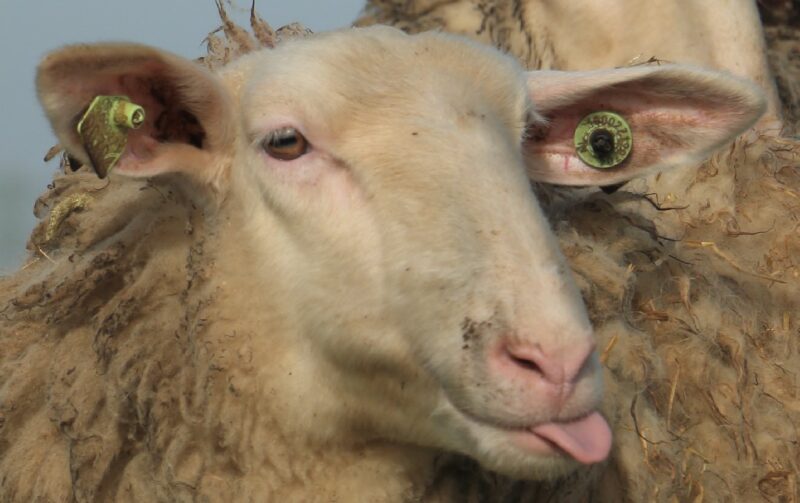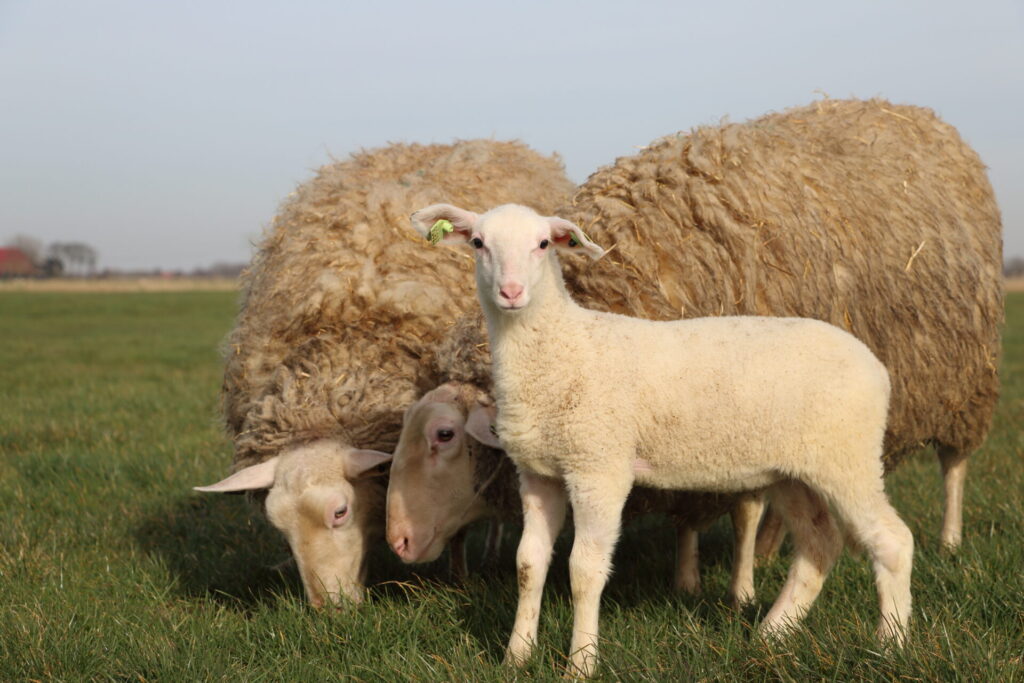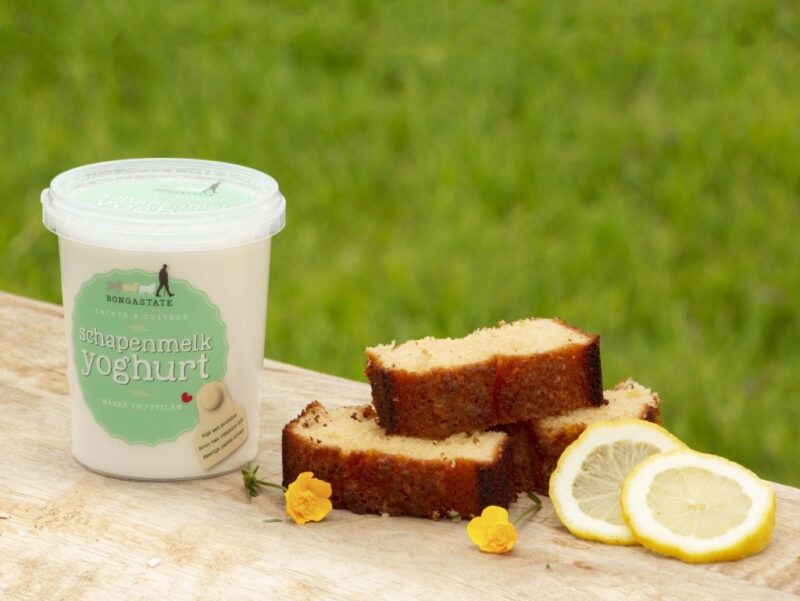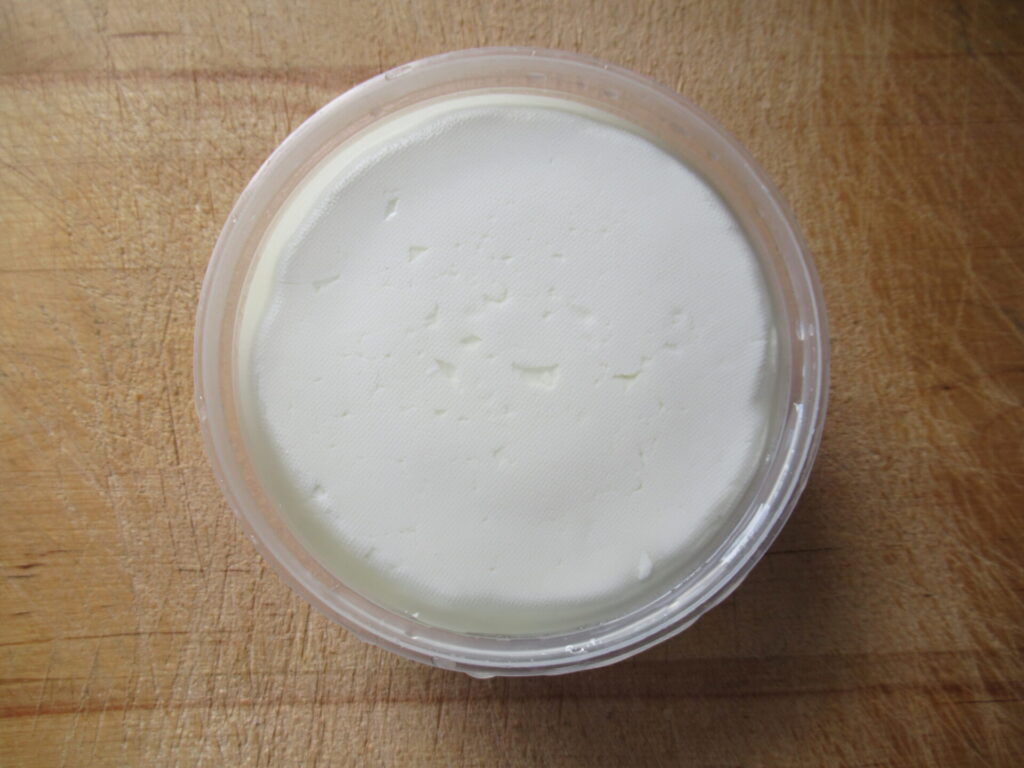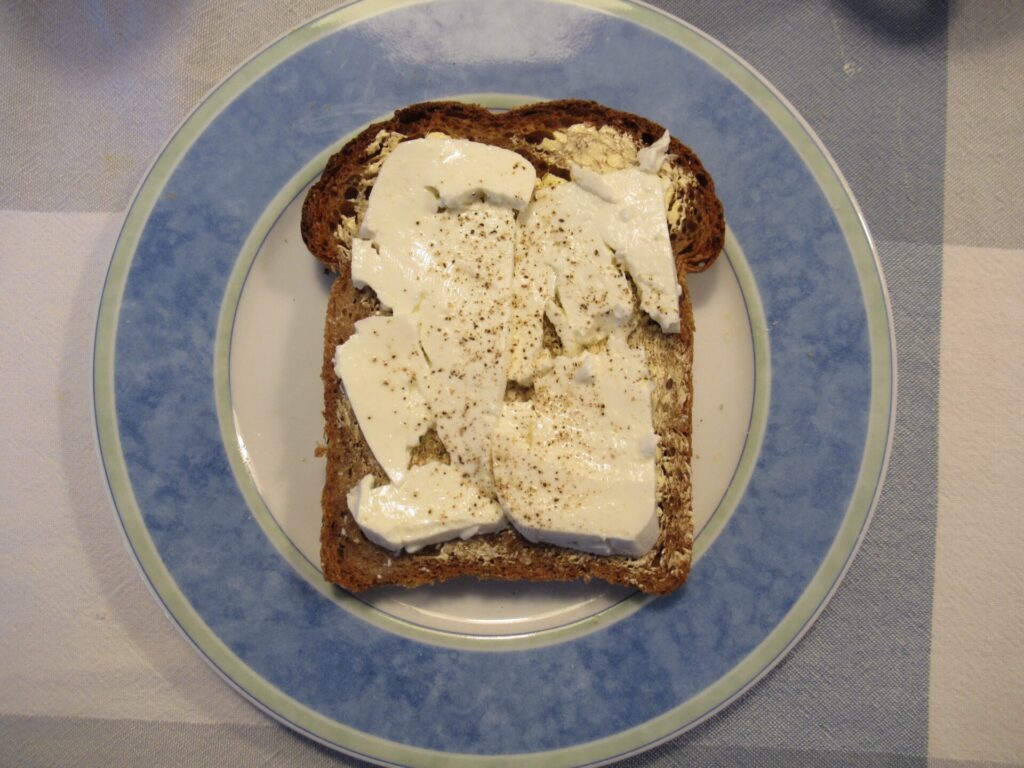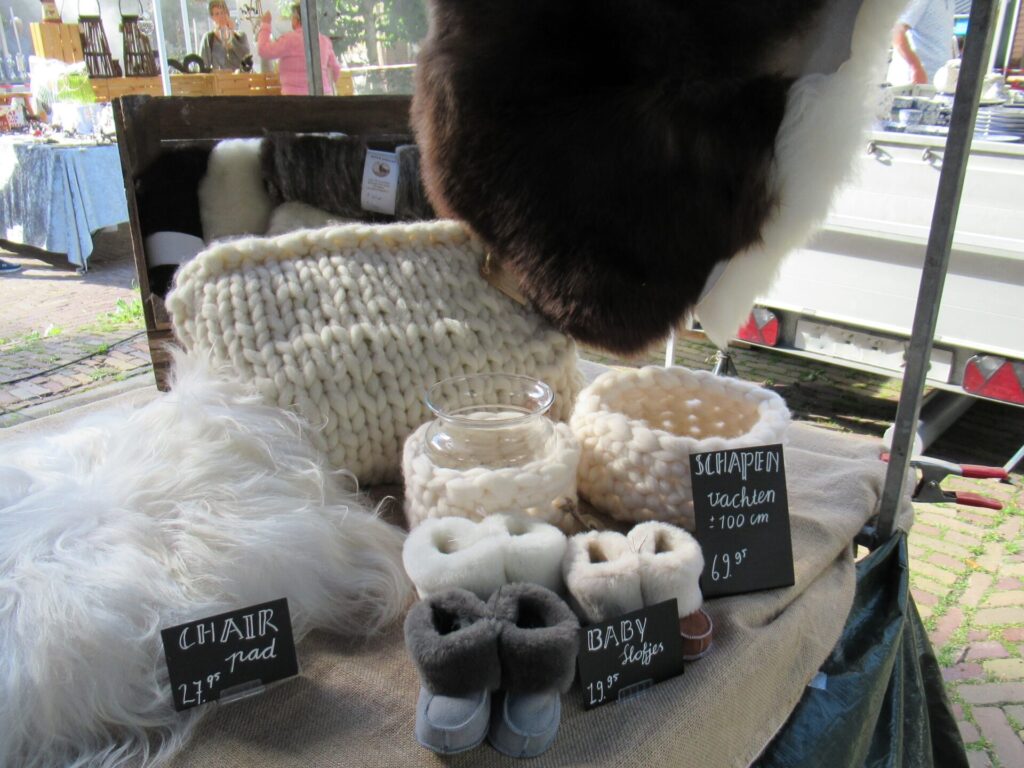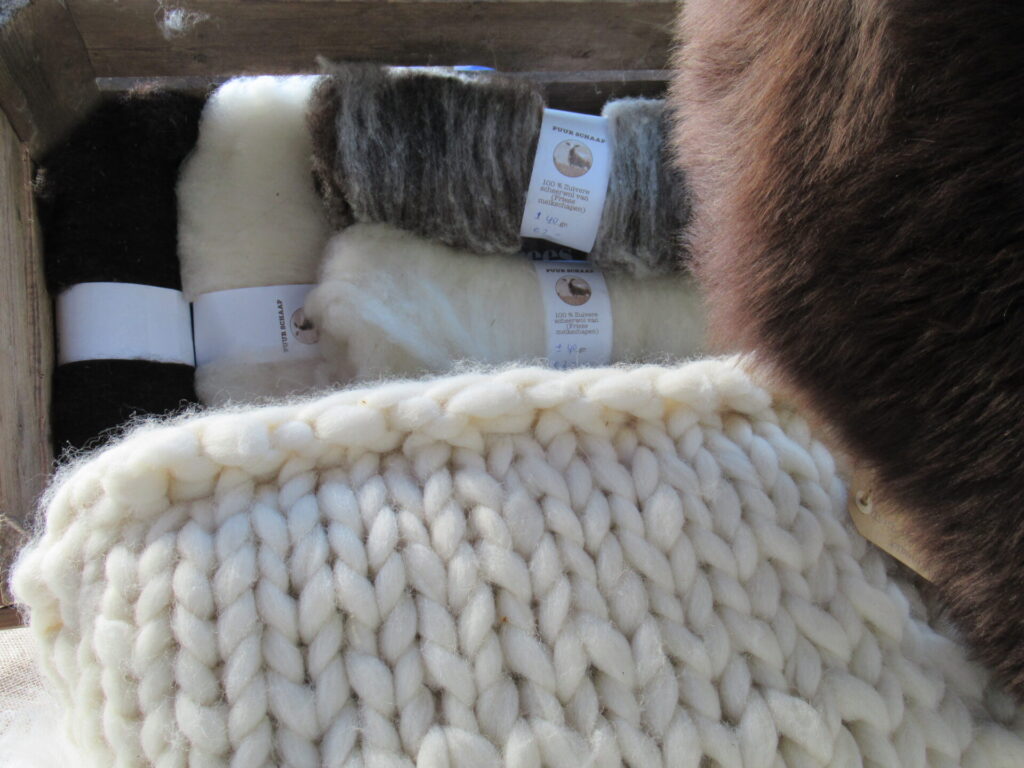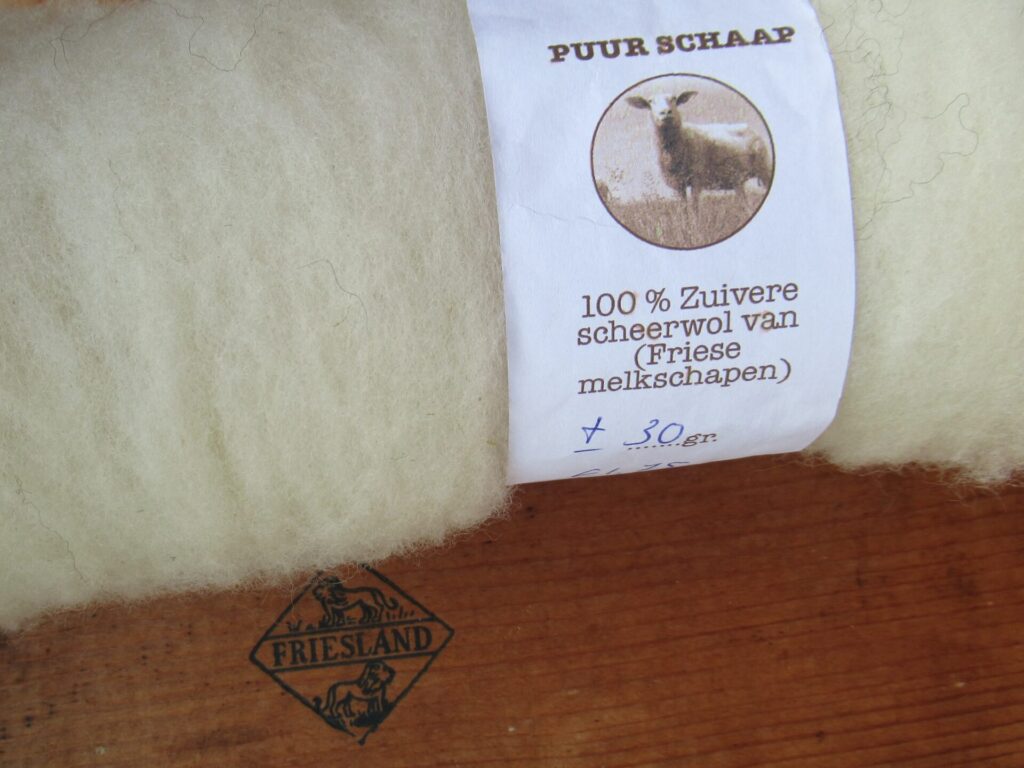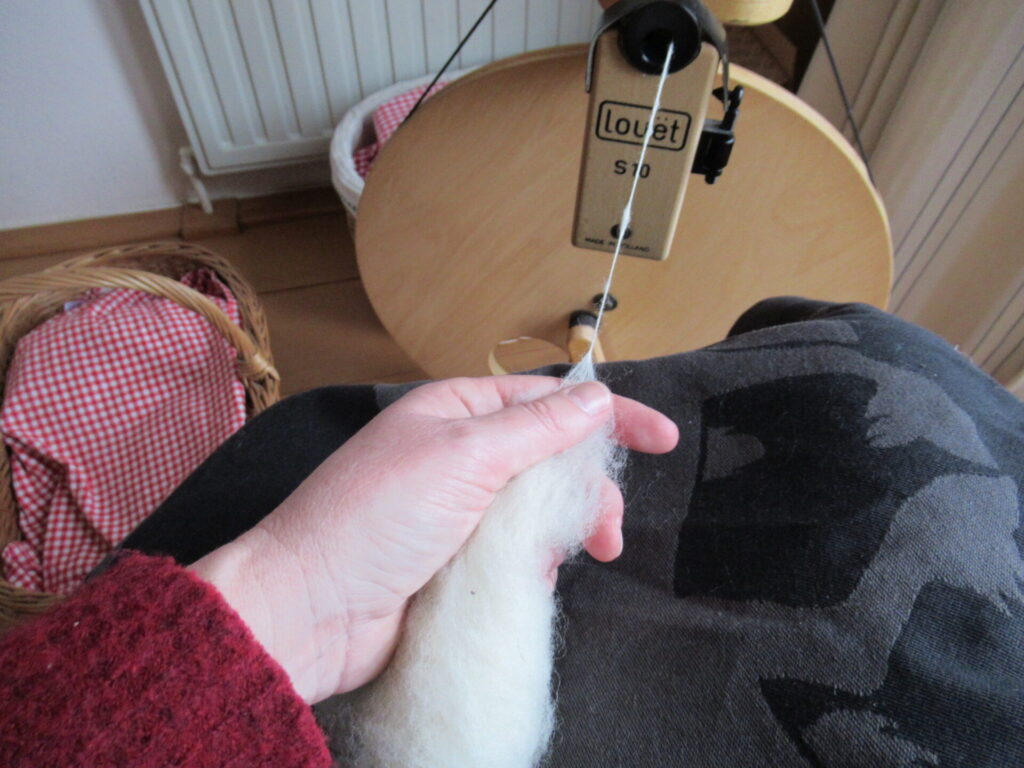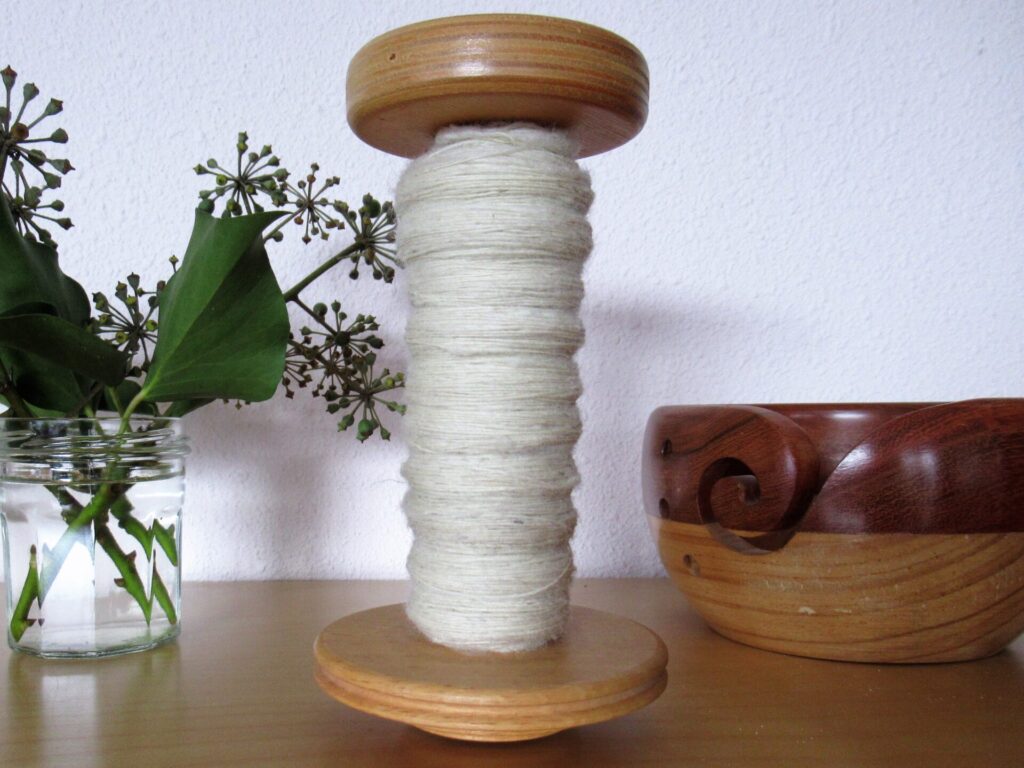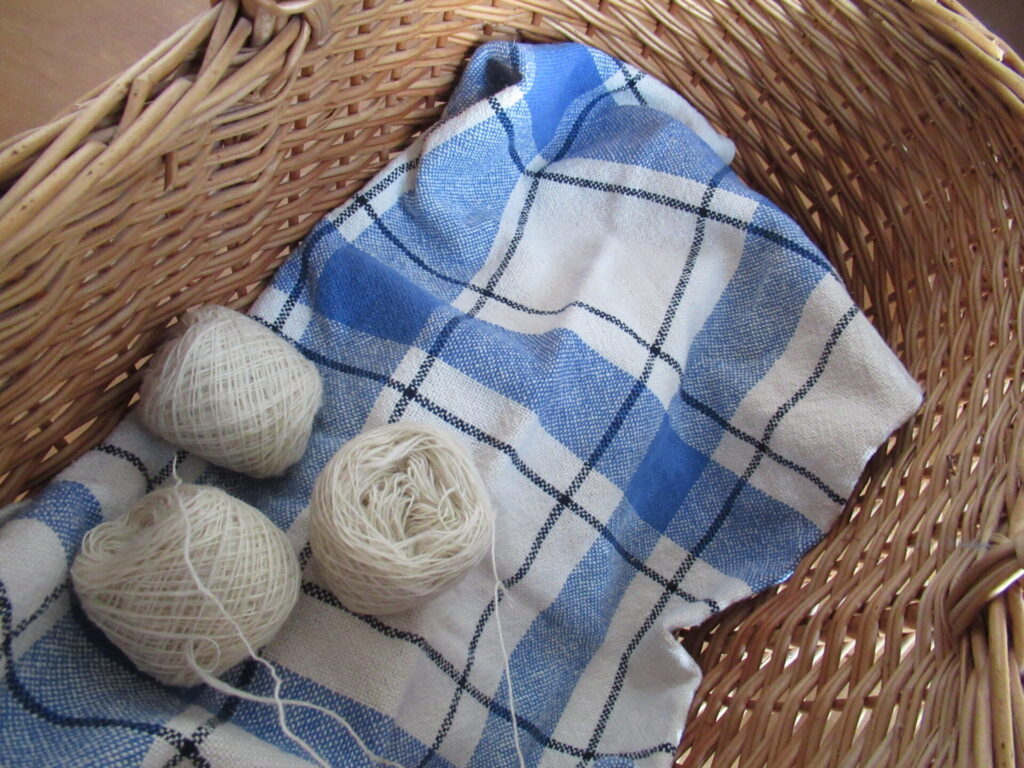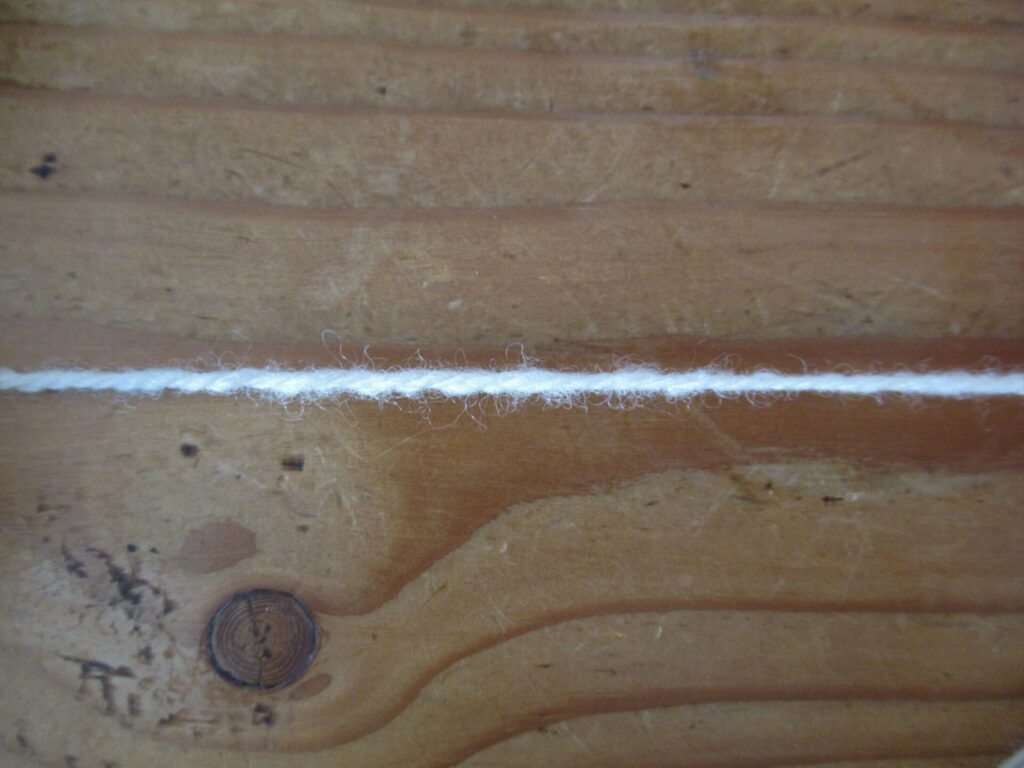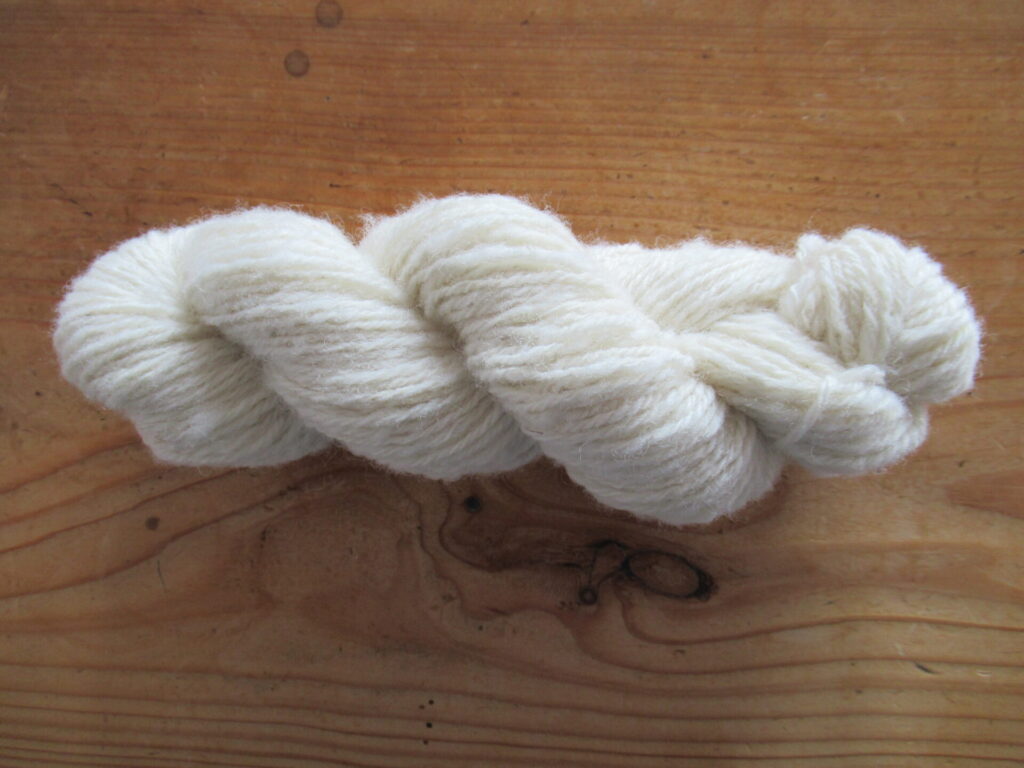spinning
Wool Rescuing
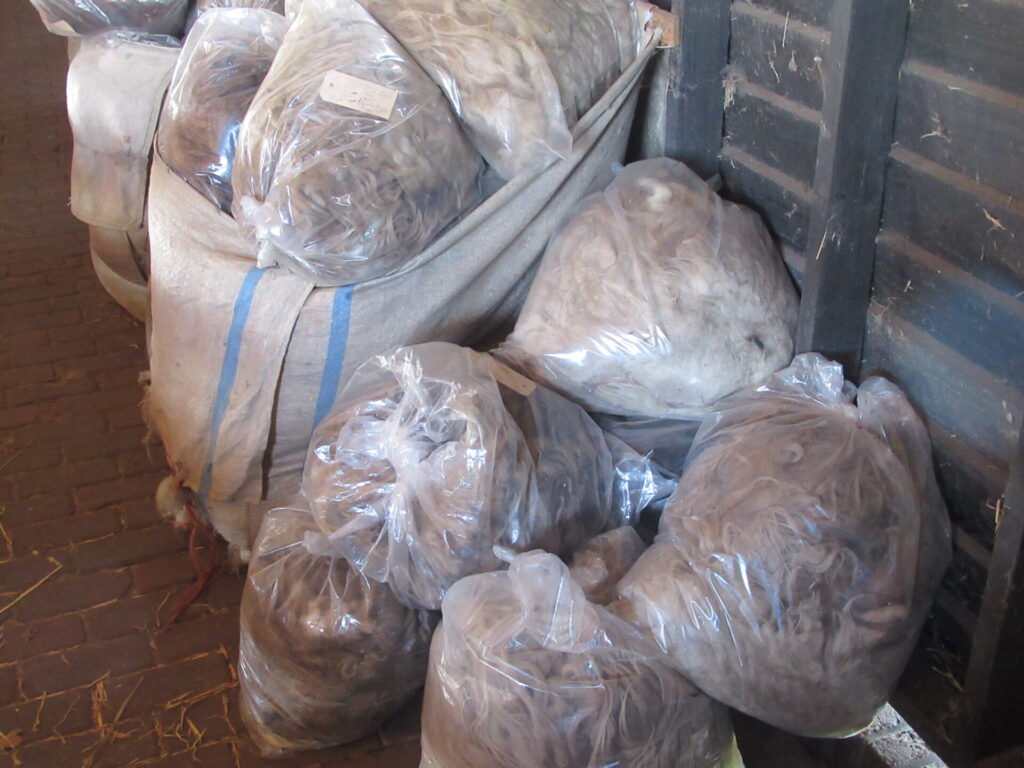
Hello!
First of all, thank you for all of your comments about the yarn colours for my fingerless mitts. You were unanimous: blue and cream for the 2-colour mitts,
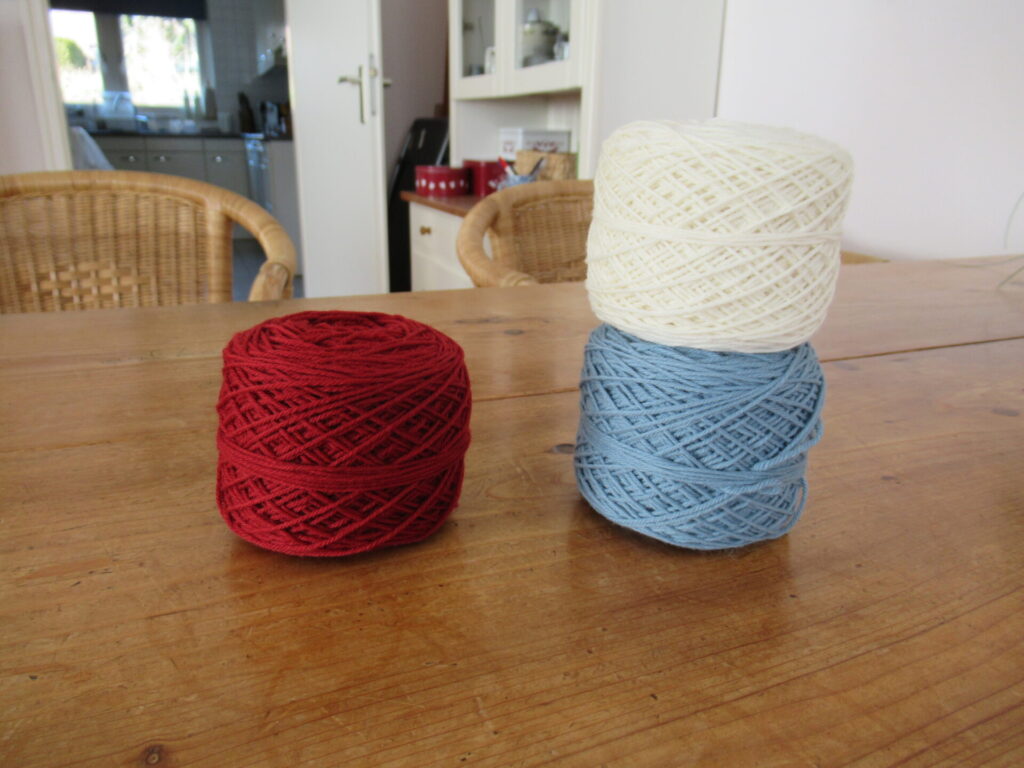
and red for the single colour version.
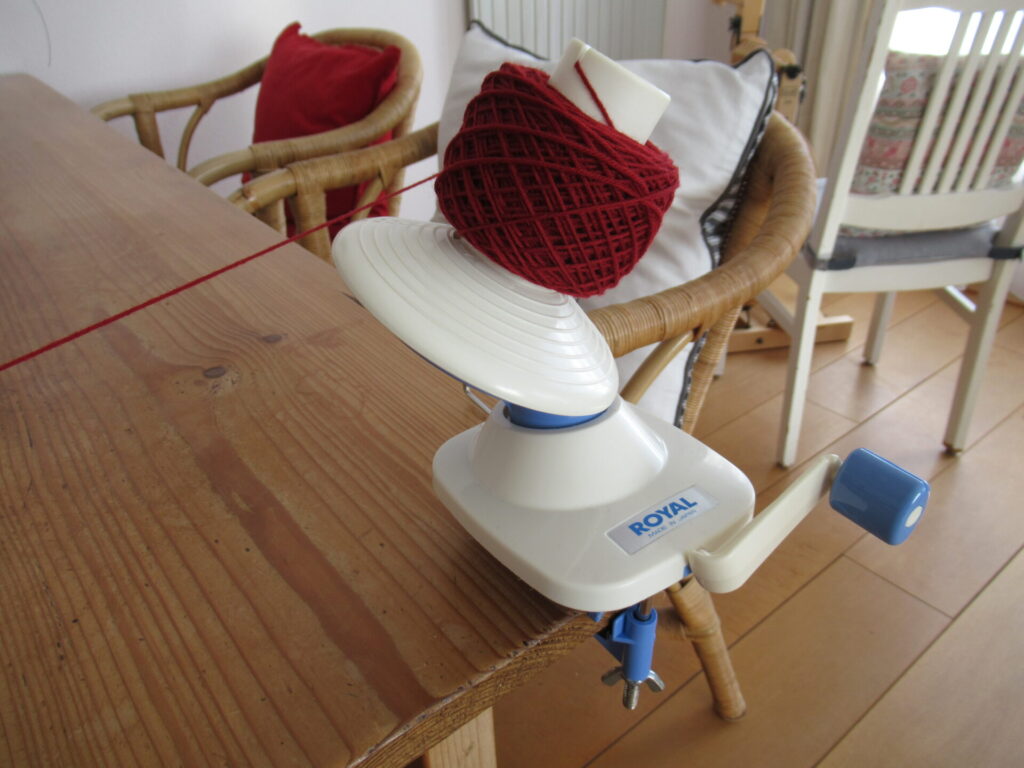
So that’s what it’s going to be. I’ve wound the yarn into balls and am looking forward to starting, but first more swatches and prototypes.
Now on to today’s subject – wool rescuing.
We have quite a few sheep in the Netherlands (at the moment about 1 million), and by far the most of them are of the Texel or Swifter breed. I photographed some of our farmer-neighbour’s Texels or Swifters (I can’t tell the two apart, to be honest) on a misty morning earlier this week.
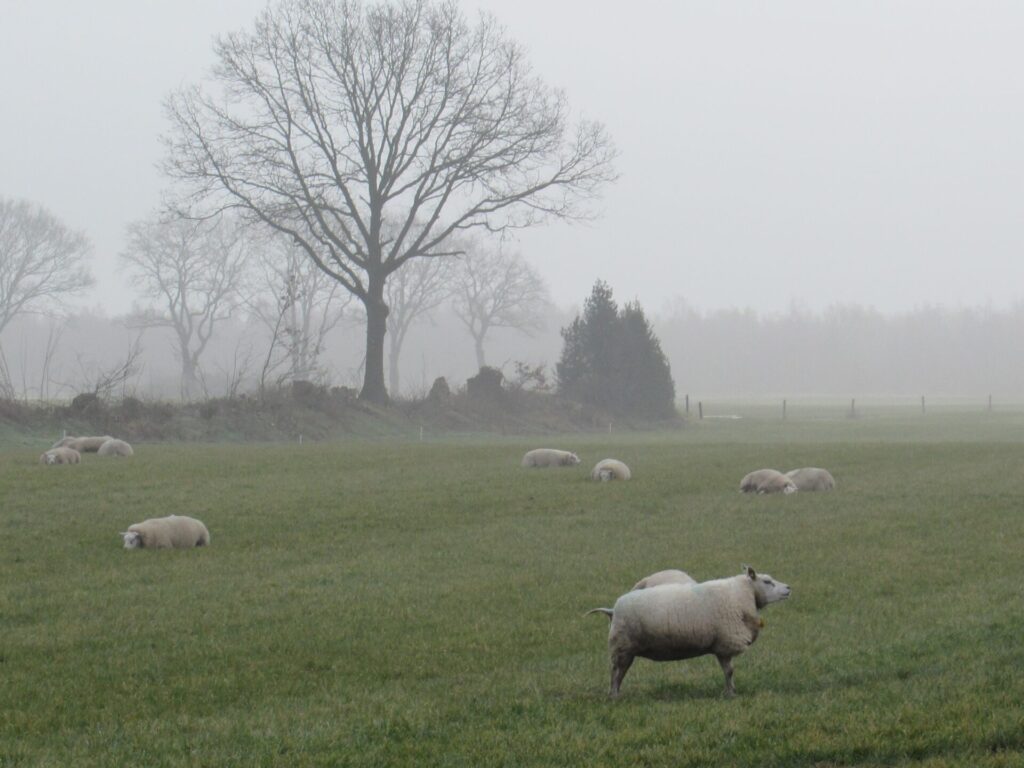
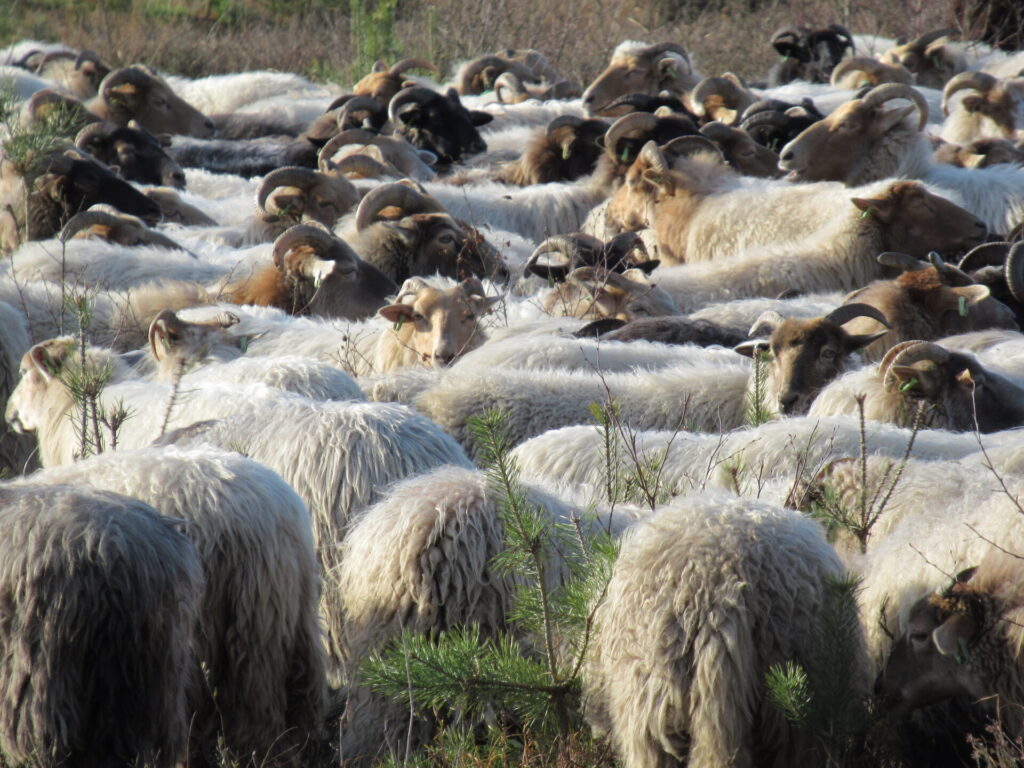
I enjoy the presence of sheep in the fields surrounding us. I love sheep’s cheese and yoghurt, and as a knitter and spinner, I am obviously also interested in their wool.
Until 1988, we had a Dutch Wool Federation – a cooperative that took care of the entire wool chain, from raw wool to end products like blankets, warm underwear and knitting yarns. They even had their own shops.
The name Nederlandse Wolfederatie still exists, but today it is an organisation that sells things like sheep shearing equipment, veterinary medicines and other things farmers may need. Seeing their buckets in our neighbour’s field evokes feelings of nostalgia for me. The logo reminds me of all the hanks of wool I transformed into pullovers, vests, cardigans and scarves as a teenager.
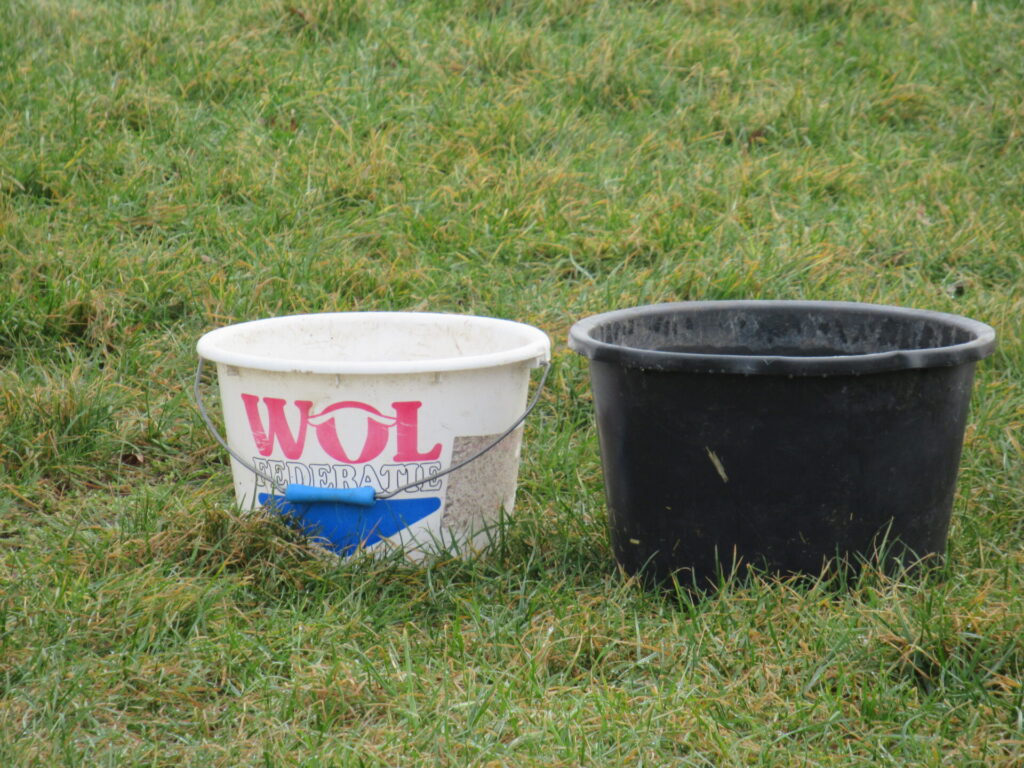
Sadly, almost all of the wool from our sheep is now considered ‘garbage’ and shipped to China, where it is used for low-grade purposes. The last spinning mill in our country closed its doors in the 1980s.
But there is good news! A group of people in Friesland have started an initiative to rescue our wool and find ways to use it locally. In 2019, they decided to adopt a flock of sheep, found people willing to spin the wool and others prepared to weave, knit and crochet blankets from them.
In spite of the Covid-restrictions, they were able to organize an exhibition of all these blankets in 2020. Hats off to them! I haven’t been able to visit the exhibition myself, but have admired the blankets on their website.
And now they have recorded their experiences in a Wool Rescue Handbook.
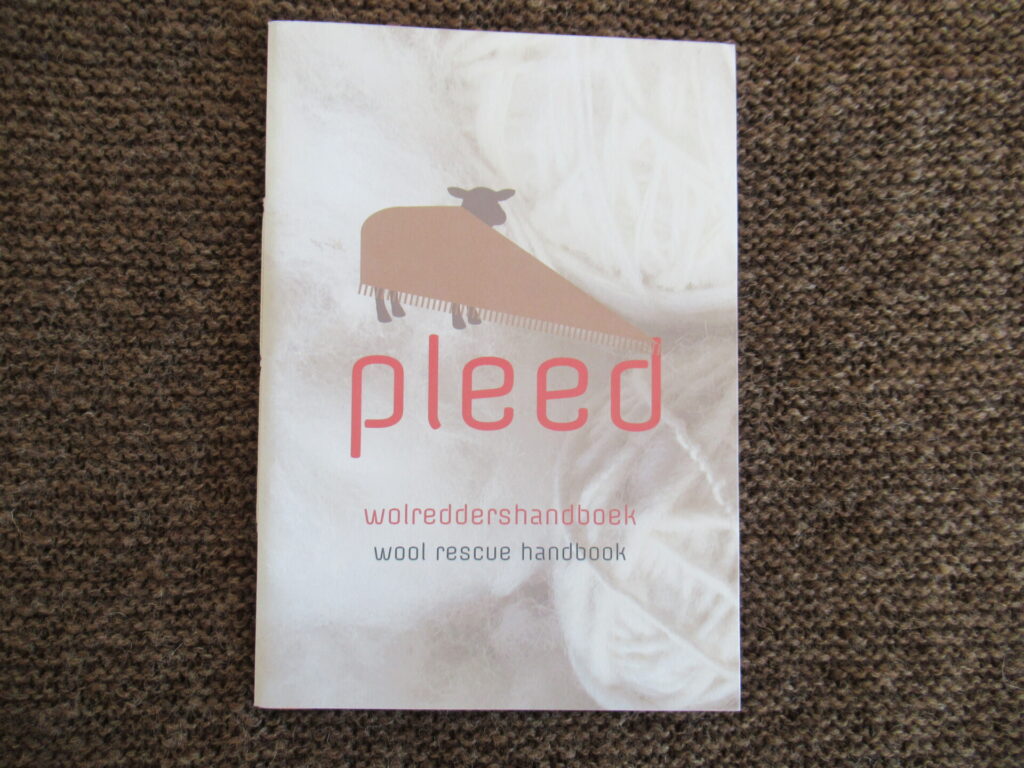
It’s a lovely 60-page booklet packed with tips and advice for anyone who would also like to rescue some (or a lot of) local wool. The text is in both Dutch and English, and is accompanied by many photographs.
With a subtle sense of humour, the booklet takes us through the entire wool-rescuing process step by step. Step one is ‘Find a sheep’. There are practical tips about washing, carding, spinning and felting. There is also a lot of information about the people side of things – finding volunteers, publicity, involving schools and so on. And they have thought about the financial side, too.
What I love about this booklet is that it is not just about how to organize things, but also about fun and enjoyment. Below you can see the pages dedicated to a very important step – ‘Enjoy’.
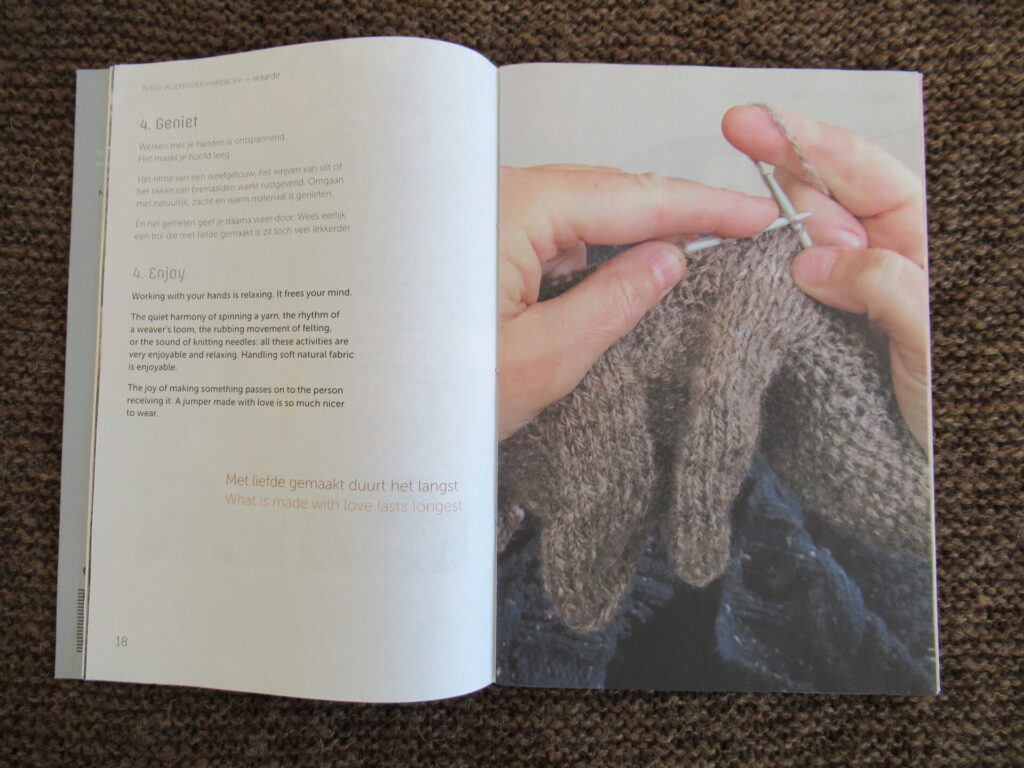
A quote from this page: ‘The joy of making something passes on to the person receiving it. A jumper made with love is so much nicer to wear.’ And another one: ‘What is made with love lasts longest.’
Apart from the actual text, everything else about the Wool Rescue Handbook also speaks of love of the entire process. The front and back flaps can be folded out and show diagrams of wool as waste versus wool as a resource. The paper for the booklet was chosen with care, the layout is done beautifully, and there are just so many interesting photos to look at.
Just look at the spread in the middle, about starting a spinning club:
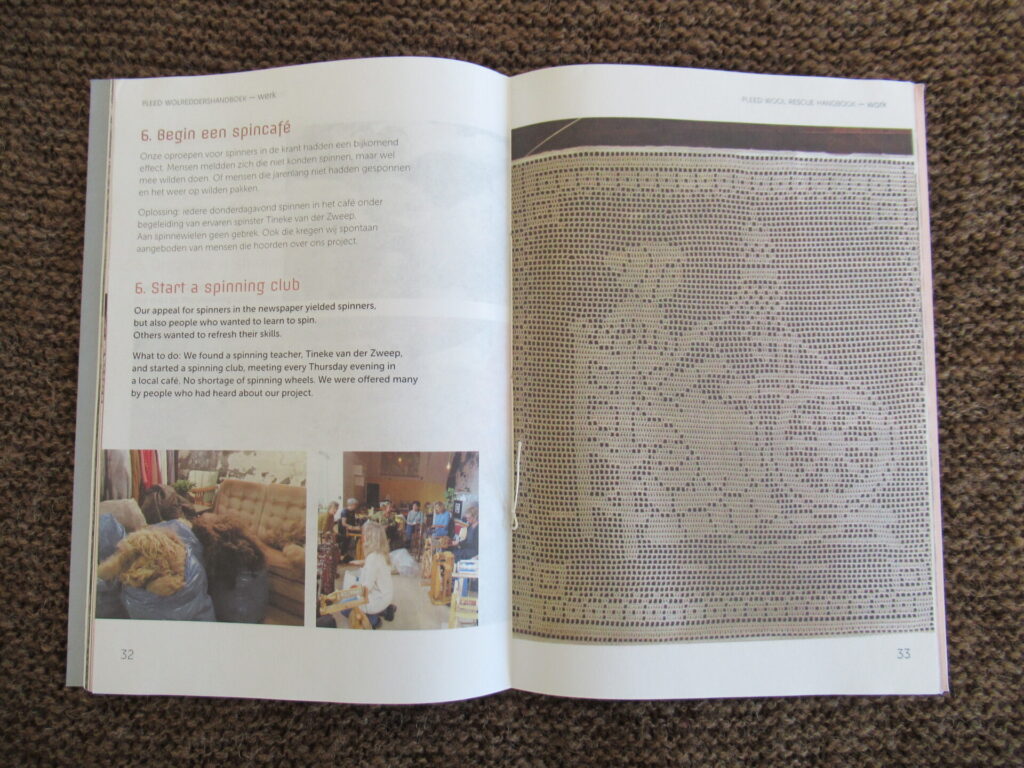
Lovely, isn’t it? The booklet has a sewn binding, and I wouldn’t be surprised if someone has spent many hours lovingly sewing every single copy by hand.
And this is just the beginning. There is now a series of baby blankets underway, and there are plans for a new spinning mill in the North of Friesland, a rug weaving studio in the Frisian capital Leeuwarden, as well as noises about similar groups in other parts of the country.
The initiative is called Pleed. (That is how the word ‘plaid’ in the meaning of throw or blanket is pronounced in Dutch.) If you’d like to know more, please visit the website (in Dutch, but with interesting photos and videos). More information about the Wool Rescue Handbook can be found here. Send them an e-mail if you’d like to order a copy.
I’m in awe of the energy and productivity of these people. I’ve never spun a blanket quantity of yarn. What I spin is a sweater quantity at most, and often even less to make a shawl or wrap.

And when it comes to wool rescuing, I’m doing that on a very modest scale, too. I’m currently spinning a tiny quantity of Friesian Dairy Sheep’s wool. More about that when it’s all spun and plied.
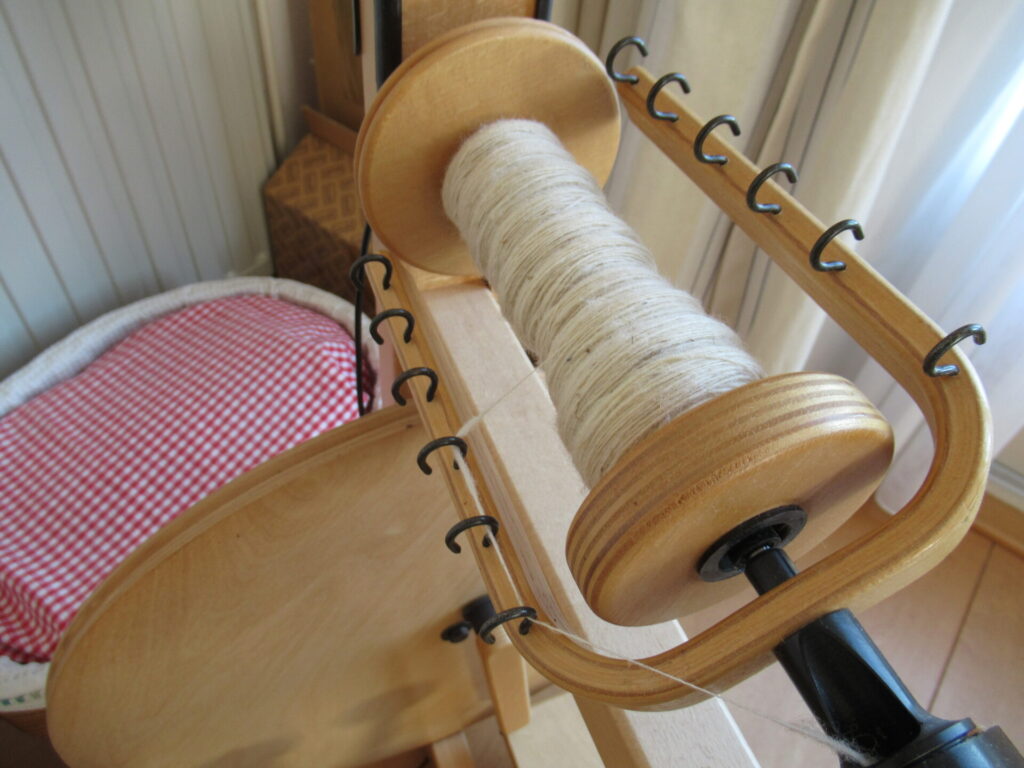
Spinning Drenthe Heath Sheep
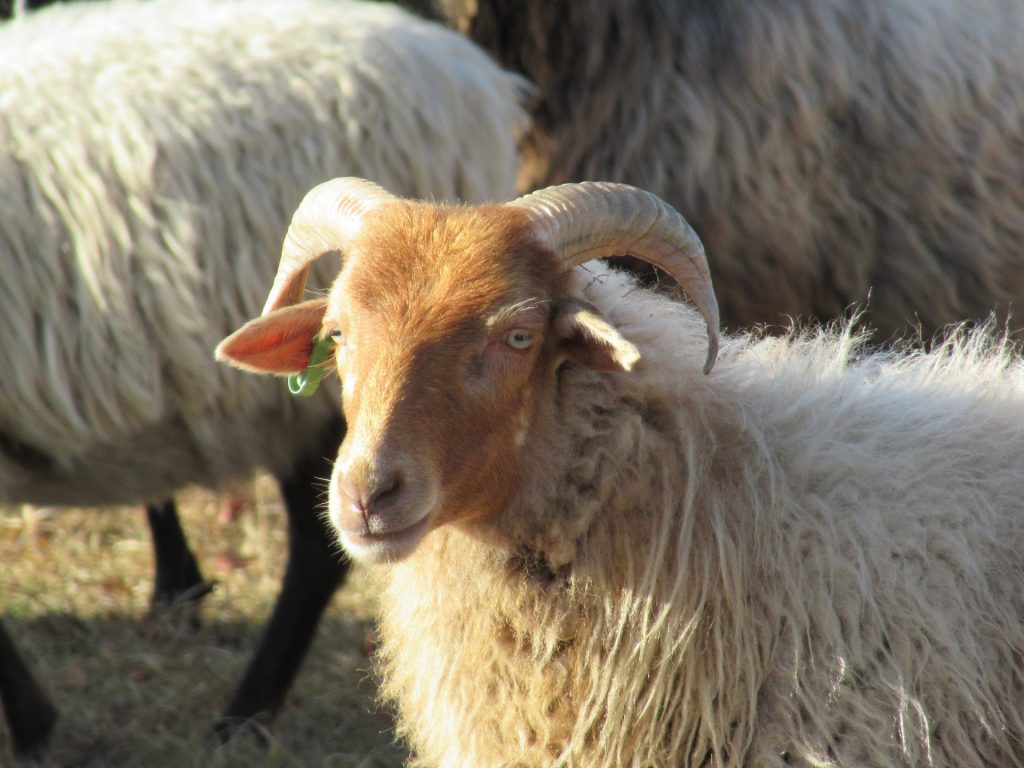
Last year, I bought a bag of Drenthe Heath sheep wool. During our walks, we often see flocks of these sheep at work in one of our national parks. They are kept for conservation grazing, and their work is eating young trees and shrubs. Without them, our open heathlands would turn into woodland in no time.
Drenthe Heath sheep are not primarily kept for their meat or fleeces, but their meat seems to be good (I’ve never tasted it) and they produce fleeces of 1 to 2 kg per sheep. I know that their wool is generally considered to be of poor quality, but still I wanted to experience for myself what it feels like, how it spins up, and what I could knit with it.
An entire fleece would be way too much for me, so I bought a bag with small quantity of prepared wool.
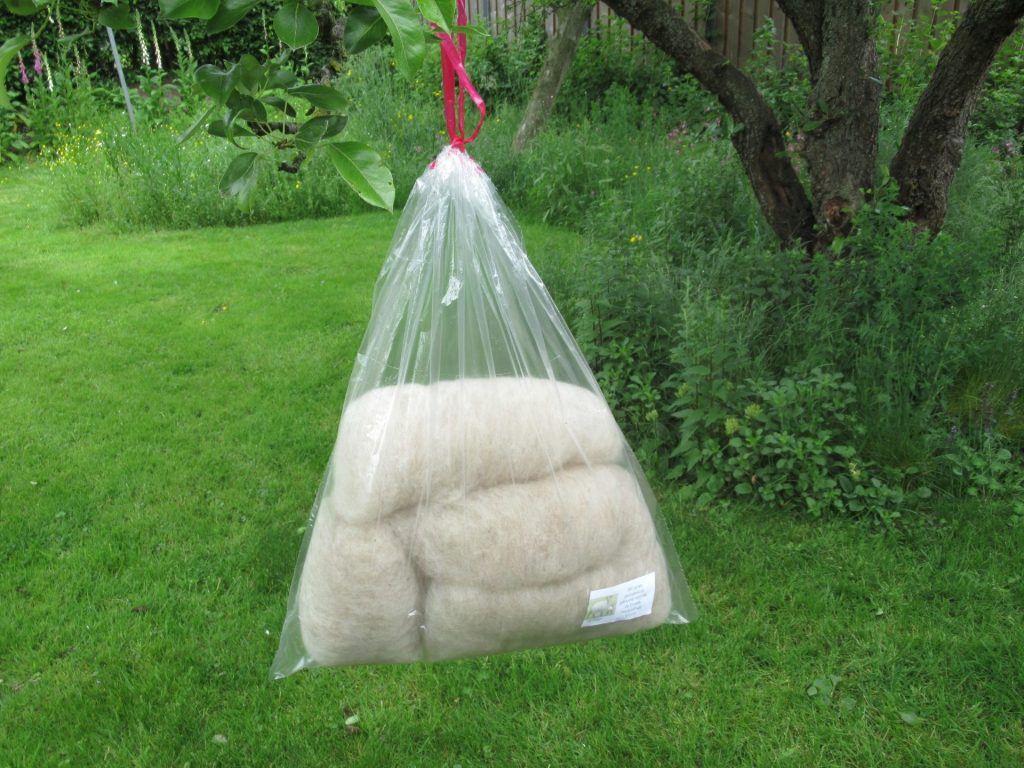
Taking the wool out of the bag, I saw that it contained five rolled-up batts, or large rolags.
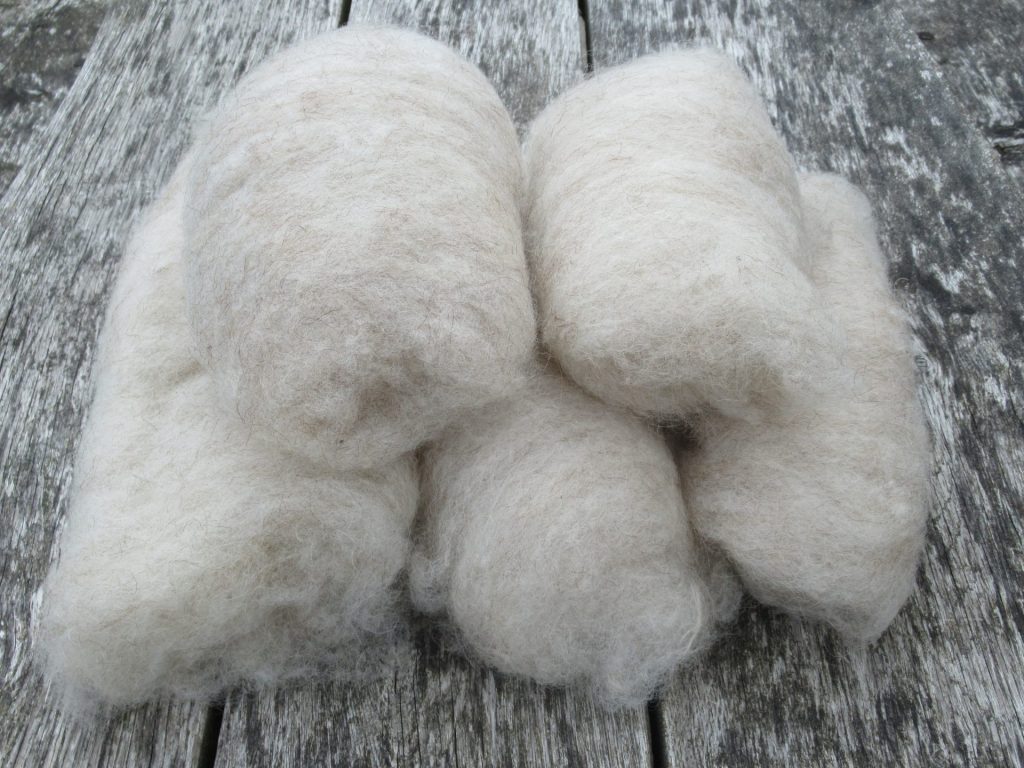
The label on the bag said, ‘150 grams. Washed and carded Drenthe Heath Sheep Wool, €10,00.’ There was also a business name on the label, but no website or contact information.
Asking around, I found out who had done all the washing and carding for me, and also that this person was going to be present at a crafts fair. Bringing a tuft of wool, I visited her stall at the fair to learn a bit more. Although she was busy selling her wares, she took the time for a chat. One of the things she said about the wool was, ‘there is quite a bit of kemp in it.’
Kemp???
‘Yes. If you look at the wool closely, you can see some dark fibres mixed in with the lighter wool. That is kemp.’
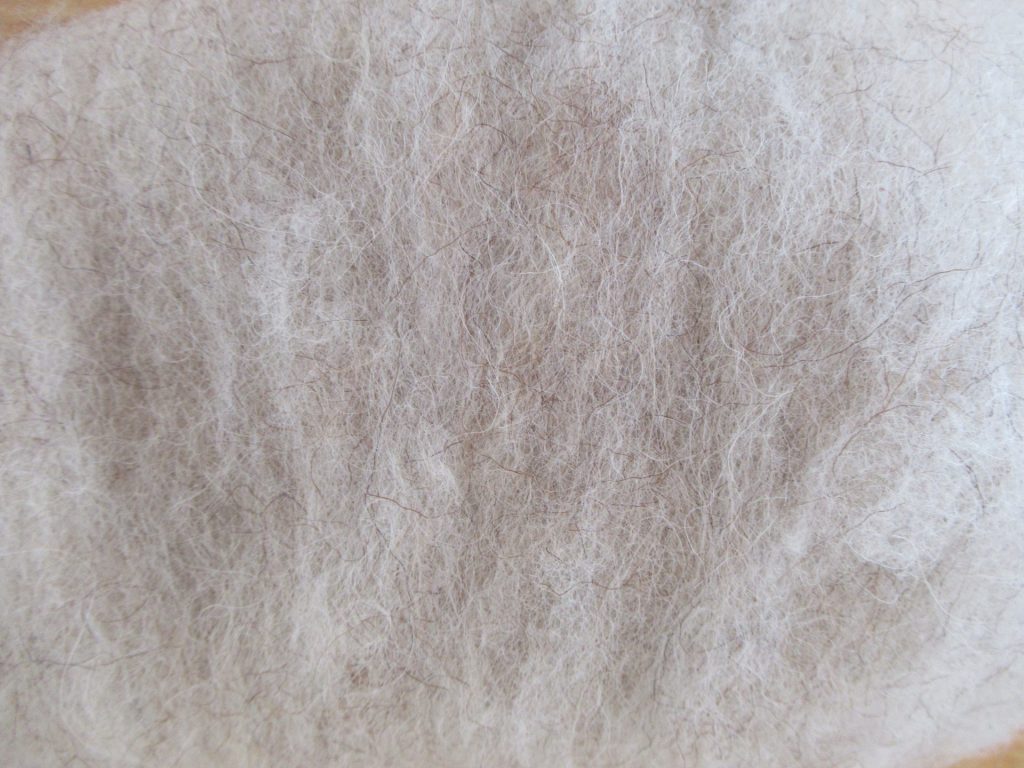
Back home I looked for more information about kemp. On p. 22 of The Spinner’s Companion Bobbie Irwin defines it as ‘Undesirable fiber found in some fleeces, especially those of more primitive breeds.’ I also found out that kemp isn’t actually wool but hair. I went on to read much, much more, including that sheep have primary and secondary follicles. It was all very interesting, but would go much too far to repeat it all here.
Summing up, all sources agree on one thing – kemp is bad news!
Only Robson and Ekarius are slightly milder in their great tome The Fleece & Fiber Sourcebook. On p. 9 they state, ‘Kemp isn’t all bad, though. Its very nature of odd dye absorption is sometimes useful, as in the production of true tweeds.’
In spite of all the bad news, I started spinning.
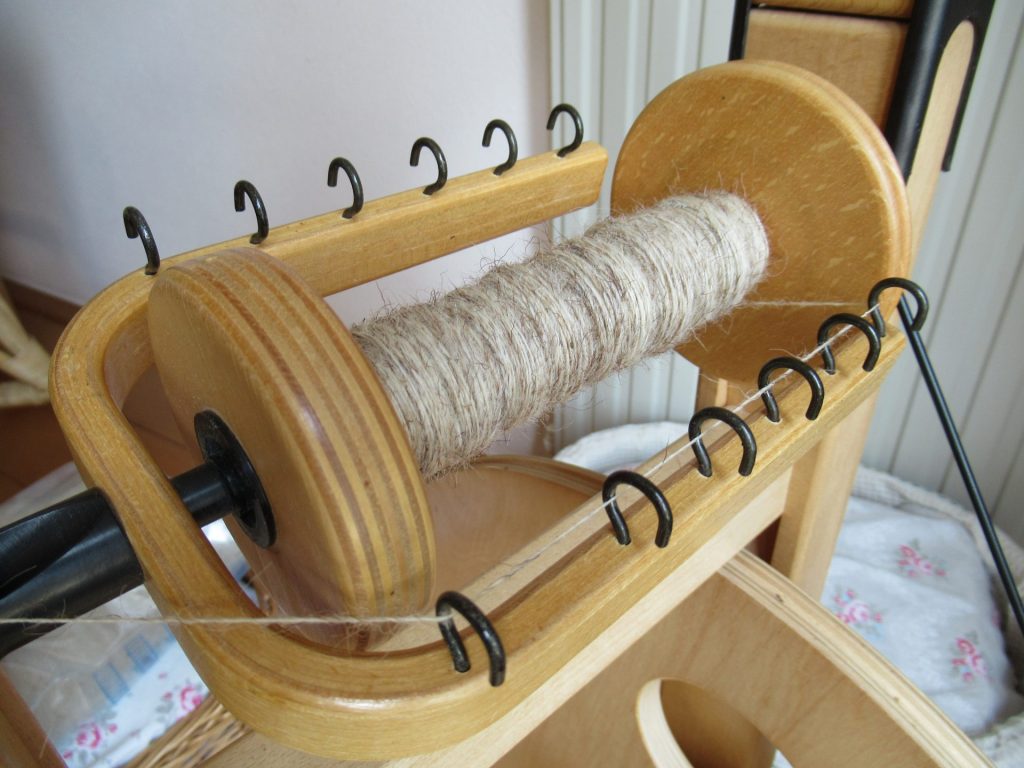
When I spin, I always have a tea towel on my lap, to protect my clothes and catch any dirt and fibres coming from the wool. For light fibres I use a dark tea towel, and for dark fibres a light one. This helps me to see what I’m doing.

I divided the wool into two equal portions and spun it into a fairly thin thread. During the spinning, the wool shed a lot of kemp. I put some on a sheet of white paper to take a closer look.

So this is kemp – short, rough, slightly curly hairs that make yarn prickly and don’t take dye well.
After spinning two bobbins full, I plied everything into a simple 2-ply yarn. While I was plying even more kemp fell out, but quite a bit stayed in too.
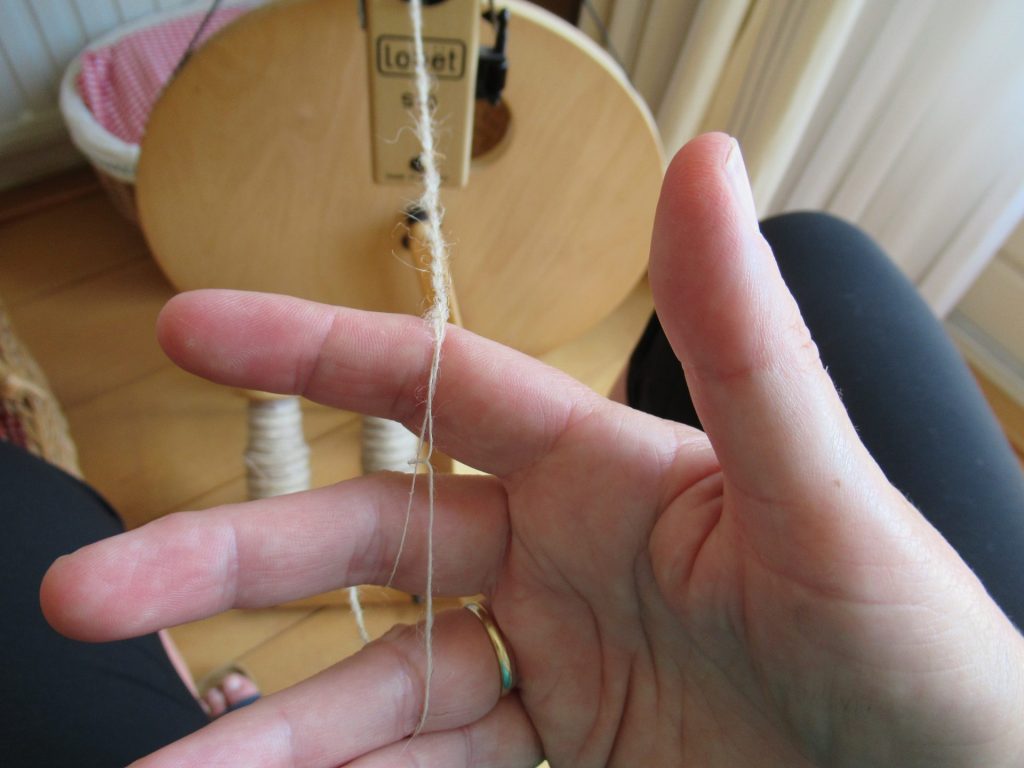
Drenthe Heath sheep can vary in colour, but their fleeces are mostly off-white. They are fairly small, hardy animals and have apparently lived in this region from about 4000 BC. My wool came from an animal like this one:
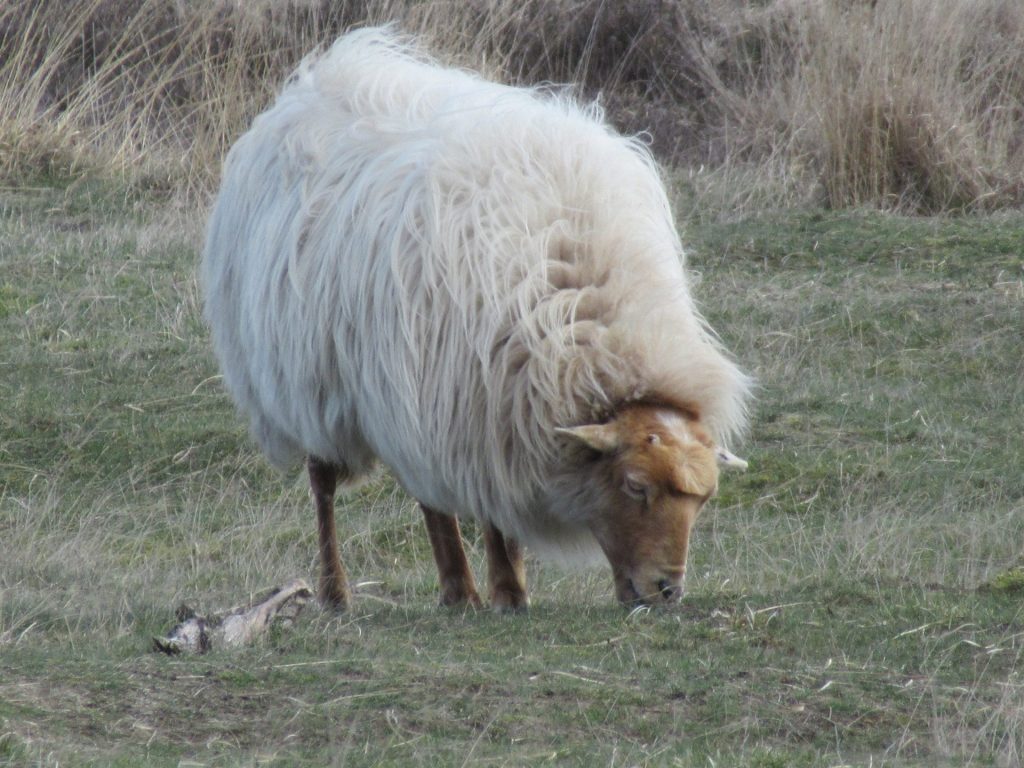
Although this isn’t the nicest wool I’ve ever spun, spinning 150 grams of Drenthe Heath Sheep wool has brought me a number of things:
- In-depth knowledge of kemp
- Several enjoyable hours of meditative treadling and drafting
- A closer connection with these animals that have lived here for thousands of years
- 135 gr/422 m/460 yds of yarn
The yarn is a sort of heathered oatmeal shade and feels, let’s say, rustic. I like it more than I expected, I have to say, but I don’t think I’d use it for something to wear.
I am also left with several question marks:
- Would it have been possible to remove the kemp entirely? How?
- If so, would the yarn still be scratchy?
- Would it have been better if I’d spun it into a thicker, loftier yarn?
- And last but not least – what could I knit with it? Hmmmmm…

If you’d like to read more about Drenthe Heath sheep, I’ve written about them here and here. And there is more information on the website of the Drenthe Heath sheep breeders’ association (mainly in Dutch, but with an English summary).
